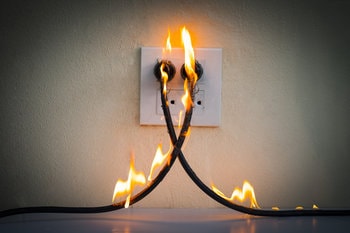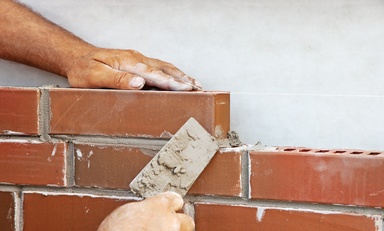 Every homeowner likes to save a buck. That's why many opt to tackle a home improvement project themselves. They think that taking a DIY approach can reduce costs and hassles. But new research suggests that for dangerous or tricky jobs, it's often worthwhile hiring a pro from the start.
Every homeowner likes to save a buck. That's why many opt to tackle a home improvement project themselves. They think that taking a DIY approach can reduce costs and hassles. But new research suggests that for dangerous or tricky jobs, it's often worthwhile hiring a pro from the start.
Home improvement: be careful out there
A new report by Clovered polled more than 1,000 homeowners across the country. Among their findings:
Nearly nine in 10 homeowners made mistakes when tackling a DIY home improvement project. And one in four injured themselves.
The most common mishaps among the injured included some pretty serious and painful events (electrocution, anyone?):
- 75% involved sharp objects and spilling blood
- 58% of injuries involved being hit with tools
- 21% fell off of ladders
- 75% reported slipping on the floor or tripping over building materials
- 14% electrocuted themselves
- 14% inhaled dangerous fumes
- 12% burned themselves
So, if you're not an expert, you should probably avoid electricity, chemicals, flames and heights. And handle sharp objects and tools carefully, like the pros do.
Related: Best Home Renovations for Investment This Year
Avoid DIY remorse
Even if you stay out of Urgent Care, a DIY fail can cost you more than a professional job would have. It can reduce your home's resale value. Or at least annoy you every time your eye lights on that crooked nail, paint drip, or loose floor board.
The eight most commonly listed DIY home improvement errors made were:
- Starting the project without the necessary tools or supplies (suffered by about 51%)
- Making incorrect measurements (40%)
- Not budgeting enough time (32%)
- Working beyond their skill level (31%)
- Exceeding their budget (28%)
- Skimping on materials (23%)
- Using the wrong paint (19%)
- Buying/using low-quality materials (15%)
Many DIY sites and YouTube videos can help you with worksheets to plan your project, estimates of how much it should cost, and tell you what the difficulty level is for a renovation. Don't go in cold.
Why many homeowners like to go it alone
Ryan Beschner is the director of consumer finance at Power Home Remodeling. He understands why many homeowners choose the DIY route.
"When tasked with home repairs, owners usually don't want to take the time or energy to contact a pro. A DIY project feels like an easy win. You can do it on your own time. It's a chance to be creative. And most importantly, it feels affordable," he says.
But DIYers often encounter obstacles at some point in the project. That's when they end up needing to enlist a professional.
"When they reach that point, they've learned that they wasted their time. And they fork out a lot of money for what was supposed to be a 'simple' project," says Beschner.
Related: Buying a Fixer Upper? Here's Your Mortgage
Many DIY projects go awry
Case in point: Craig Russell, founder/CEO of The English Contractor, says his firm recently remodeled a kitchen where big surprises were found behind the walls.
"We found a spaghetti-like mass of wiring left behind by a well-intentioned but ill-informed DIYer. Problem is, doing electrical work yourself can cause a fire or appliance damage," cautions Russell.
Realtor and property attorney Bruce Ailion brings up another DIY dilemma.
"Ripping out a wall, you may find mold or structural damage," says Ailion. "You may even find asbestos or lead paint that require specialized removal. Governmental jurisdictions may also require upgrades to modern code that necessitate the hiring of specialized trades. These things may be hidden from or improperly resolved by a DIYer. But they would be reasonably anticipated and easier to manage by a pro."
Incorrect installation of wallpaper is a further example of a project that a homeowner can bungle.
"This can be a perfect DIY project. But it requires the right tools and preparation," notes Russell. "We've seen a lot of wallpaper glued to unprimed walls. That destroys the drywall, making its removal a messy undertaking."
Poor tile installation is another project that the experts get called in to fix.
"It seems like an easy enough job to install sheets of tile and grout. But many homeowners fail to realize the careful prep and planning it requires," adds Russell. "We recently worked on a tile shower that had tile applied directly to drywall without a waterproof backboard."
Save big on the right projects
The best projects for saving money have three common traits:
- They are relatively safe
- They involve a lot of labor but not too much training
- It is fairly easy to fix a mistake
Tedious, large jobs like tile, flooring, cabinet finishing and painting come to mind. (Except when they involve big heights or unsafe spaces). if you mess up a tile or splash a little paint, you can fix it at minimal cost. And these jobs tend to be expensive, so the amount of savings on the table can be significant.
However, these are also jobs that impatient DIYers can botch in their rush to complete them. And then the result is amateurish. So avoid mistakes 1, 3 and 4. Or admit that you don't have the temperament for grinding out the job and just hire a pro.
Related: Can You Make a Living Flipping Houses Today?
Proper planning and budgeting is essential
Tonya Bruin, CEO of To Do-Done, says one of the biggest mistakes homeowners make when planning a DIY project is being unrealistic.
"Having the ambition and confidence to do the job yourself is great. But if you don't have the actual skills to finish the project you're hoping for, it will cost you more money than hiring a professional," she says.
An even bigger problem? Improperly estimating how much a project will likely cost.
"It's important to set a proper budget," suggests Beschner. "You need to identify what is really needed on the job. And you have to understand how much those items actually cost before starting work."
The right financing can make things easier
It's not easy to accurately budget for a project. Materials and labor often prove costlier than you anticipated. That's why it can be smart to pursue a fail-safe funding option ahead of time. Three popular choices to finance a home improvement project include:
- A home equity loan. You can take large or small loans against the equity in your home. For small amounts or for projects that you'll complete in stages, a HELOC (line of credit) is likely your best option. they cost very little to set up and you only pay interest on money you use. For larger projects, a home equity loan with a fixed interest rate makes budgeting easier and offers a longer repayment.
- An unsecured personal home improvement loan. Personal loans usually come with fixed interest rates. In fact, their interest rates rival those of home equity loans if you're very highly qualified. You can get the money very quickly, in hours or days. But for those with lower credit scores, secured loans like home equity or cash out refinances are likely to be cheaper.
- A cash-out refinance. This choice allows you to replace your mortgage with a new, larger loan. The difference between the payoff of the old loan and the balance of the new one is cash for your home improvements. This will likely yield the lowest interest rate, but these loans take the longest to process and they have the highest closing costs. Don't take one unless: the new loan has a better interest rate than the one you have already, and the cost of a cash-out refinance is lower than simply refinancing the old loan and adding a home equity loan for the extra. Often, that is less expensive than a cash out refinance.
Whether you choose to undertake the home improvement project yourself or trust in an expert, it's important to budget carefully. Likewise, it's crucial to have the necessary cash in place. Careful planning for both the project and the financing can help ensure a successful outcome.
Compare home improvement loan offers now



